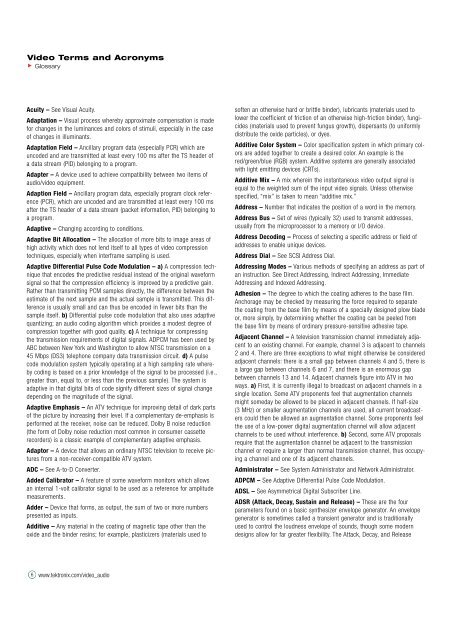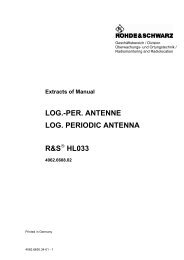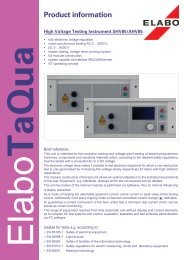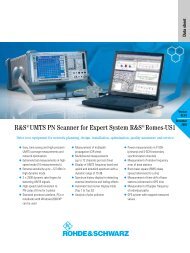Glossary of Video Terms and Acronyms - Isotest
Glossary of Video Terms and Acronyms - Isotest
Glossary of Video Terms and Acronyms - Isotest
Create successful ePaper yourself
Turn your PDF publications into a flip-book with our unique Google optimized e-Paper software.
<strong>Video</strong> <strong>Terms</strong> <strong>and</strong> <strong>Acronyms</strong><br />
<strong>Glossary</strong><br />
Acuity – See Visual Acuity.<br />
Adaptation – Visual process whereby approximate compensation is made<br />
for changes in the luminances <strong>and</strong> colors <strong>of</strong> stimuli, especially in the case<br />
<strong>of</strong> changes in illuminants.<br />
Adaptation Field – Ancillary program data (especially PCR) which are<br />
uncoded <strong>and</strong> are transmitted at least every 100 ms after the TS header <strong>of</strong><br />
a data stream (PID) belonging to a program.<br />
Adapter – A device used to achieve compatibility between two items <strong>of</strong><br />
audio/video equipment.<br />
Adaption Field – Ancillary program data, especially program clock reference<br />
(PCR), which are uncoded <strong>and</strong> are transmitted at least every 100 ms<br />
after the TS header <strong>of</strong> a data stream (packet information, PID) belonging to<br />
a program.<br />
Adaptive – Changing according to conditions.<br />
Adaptive Bit Allocation – The allocation <strong>of</strong> more bits to image areas <strong>of</strong><br />
high activity which does not lend itself to all types <strong>of</strong> video compression<br />
techniques, especially when interframe sampling is used.<br />
Adaptive Differential Pulse Code Modulation – a) A compression technique<br />
that encodes the predictive residual instead <strong>of</strong> the original waveform<br />
signal so that the compression efficiency is improved by a predictive gain.<br />
Rather than transmitting PCM samples directly, the difference between the<br />
estimate <strong>of</strong> the next sample <strong>and</strong> the actual sample is transmitted. This difference<br />
is usually small <strong>and</strong> can thus be encoded in fewer bits than the<br />
sample itself. b) Differential pulse code modulation that also uses adaptive<br />
quantizing; an audio coding algorithm which provides a modest degree <strong>of</strong><br />
compression together with good quality. c) A technique for compressing<br />
the transmission requirements <strong>of</strong> digital signals. ADPCM has been used by<br />
ABC between New York <strong>and</strong> Washington to allow NTSC transmission on a<br />
45 Mbps (DS3) telephone company data transmission circuit. d) A pulse<br />
code modulation system typically operating at a high sampling rate whereby<br />
coding is based on a prior knowledge <strong>of</strong> the signal to be processed (i.e.,<br />
greater than, equal to, or less than the previous sample). The system is<br />
adaptive in that digital bits <strong>of</strong> code signify different sizes <strong>of</strong> signal change<br />
depending on the magnitude <strong>of</strong> the signal.<br />
Adaptive Emphasis – An ATV technique for improving detail <strong>of</strong> dark parts<br />
<strong>of</strong> the picture by increasing their level. If a complementary de-emphasis is<br />
performed at the receiver, noise can be reduced. Dolby B noise reduction<br />
(the form <strong>of</strong> Dolby noise reduction most common in consumer cassette<br />
recorders) is a classic example <strong>of</strong> complementary adaptive emphasis.<br />
Adaptor – A device that allows an ordinary NTSC television to receive pictures<br />
from a non-receiver-compatible ATV system.<br />
ADC – See A-to-D Converter.<br />
Added Calibrator – A feature <strong>of</strong> some waveform monitors which allows<br />
an internal 1-volt calibrator signal to be used as a reference for amplitude<br />
measurements.<br />
Adder – Device that forms, as output, the sum <strong>of</strong> two or more numbers<br />
presented as inputs.<br />
Additive – Any material in the coating <strong>of</strong> magnetic tape other than the<br />
oxide <strong>and</strong> the binder resins; for example, plasticizers (materials used to<br />
6 www.tektronix.com/video_audio<br />
s<strong>of</strong>ten an otherwise hard or brittle binder), lubricants (materials used to<br />
lower the coefficient <strong>of</strong> friction <strong>of</strong> an otherwise high-friction binder), fungicides<br />
(materials used to prevent fungus growth), dispersants (to uniformly<br />
distribute the oxide particles), or dyes.<br />
Additive Color System – Color specification system in which primary colors<br />
are added together to create a desired color. An example is the<br />
red/green/blue (RGB) system. Additive systems are generally associated<br />
with light emitting devices (CRTs).<br />
Additive Mix – A mix wherein the instantaneous video output signal is<br />
equal to the weighted sum <strong>of</strong> the input video signals. Unless otherwise<br />
specified, “mix” is taken to mean “additive mix.”<br />
Address – Number that indicates the position <strong>of</strong> a word in the memory.<br />
Address Bus – Set <strong>of</strong> wires (typically 32) used to transmit addresses,<br />
usually from the microprocessor to a memory or I/O device.<br />
Address Decoding – Process <strong>of</strong> selecting a specific address or field <strong>of</strong><br />
addresses to enable unique devices.<br />
Address Dial – See SCSI Address Dial.<br />
Addressing Modes – Various methods <strong>of</strong> specifying an address as part <strong>of</strong><br />
an instruction. See Direct Addressing, Indirect Addressing, Immediate<br />
Addressing <strong>and</strong> Indexed Addressing.<br />
Adhesion – The degree to which the coating adheres to the base film.<br />
Anchorage may be checked by measuring the force required to separate<br />
the coating from the base film by means <strong>of</strong> a specially designed plow blade<br />
or, more simply, by determining whether the coating can be peeled from<br />
the base film by means <strong>of</strong> ordinary pressure-sensitive adhesive tape.<br />
Adjacent Channel – A television transmission channel immediately adjacent<br />
to an existing channel. For example, channel 3 is adjacent to channels<br />
2 <strong>and</strong> 4. There are three exceptions to what might otherwise be considered<br />
adjacent channels: there is a small gap between channels 4 <strong>and</strong> 5, there is<br />
a large gap between channels 6 <strong>and</strong> 7, <strong>and</strong> there is an enormous gap<br />
between channels 13 <strong>and</strong> 14. Adjacent channels figure into ATV in two<br />
ways. a) First, it is currently illegal to broadcast on adjacent channels in a<br />
single location. Some ATV proponents feel that augmentation channels<br />
might someday be allowed to be placed in adjacent channels. If half-size<br />
(3 MHz) or smaller augmentation channels are used, all current broadcasters<br />
could then be allowed an augmentation channel. Some proponents feel<br />
the use <strong>of</strong> a low-power digital augmentation channel will allow adjacent<br />
channels to be used without interference. b) Second, some ATV proposals<br />
require that the augmentation channel be adjacent to the transmission<br />
channel or require a larger than normal transmission channel, thus occupying<br />
a channel <strong>and</strong> one <strong>of</strong> its adjacent channels.<br />
Administrator – See System Administrator <strong>and</strong> Network Administrator.<br />
ADPCM – See Adaptive Differential Pulse Code Modulation.<br />
ADSL – See Asymmetrical Digital Subscriber Line.<br />
ADSR (Attack, Decay, Sustain <strong>and</strong> Release) – These are the four<br />
parameters found on a basic synthesizer envelope generator. An envelope<br />
generator is sometimes called a transient generator <strong>and</strong> is traditionally<br />
used to control the loudness envelope <strong>of</strong> sounds, though some modern<br />
designs allow for far greater flexibility. The Attack, Decay, <strong>and</strong> Release





